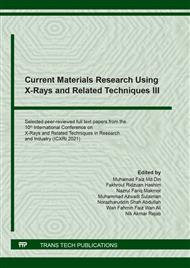p.253
p.259
p.265
p.271
p.278
p.284
p.293
p.299
p.308
Interfacial Reaction between SAC3807 Lead-Free Solders and Different Copper Substrate via Reflow Soldering Process
Abstract:
The different composition material of copper substrate significantly affects the intermetallic compound (IMC) formation and the solder joints durability. This study was conducted on the interfacial reaction between lead-free solder and the different copper substrates via reflow soldering. The selected substrate is copper (Cu) and copper-beryllium (Cu-Be). The lead-free solder involved is Sn-3.8Ag-0.7Cu (SAC3807) solder ball with a diameter of 700 μm. All the samples were subjected to the isothermal aging process. The material characterization and analysis on the IMC formation were examined by scanning electron microscopy (SEM), optical microscope (OM), and energy dispersive X-ray analysis (EDX). After the reflow process, the result revealed that Cu3Sn, Cu6Sn5 IMC layer formed at SAC3870/Cu and SAC3870/Cu-Be interface. The changes to a rod-like shape Cu6Sn5 and irregular needle-shaped Cu3Sn4 occur after the aging treatment on SAC3870/ Cu. Meanwhile, the IMC layer for SAC3870/Cu-Be shows a rod-like shape transformed into a blocky-like shape Cu6Sn5 and Cu3Sn4 diamond-shape. This result indicates that Ag3Sn nanosized was formed on the intermetallic surface during the aging process for both SAC3807/Cu and SAC3807/Cu-Be. The Ag3Sn nanosized element at SAC3807/Cu-Be is many compared to SAC3807/Cu. In addition, IMC thickness for SAC3807/Cu-Be shows a thicker layer than SAC3807/Cu. Lastly, in this research, the element of Be in SAC3807/Cu-Be cannot be defined because the beryllium element is not easily detected as the percentage was very low.
Info:
Periodical:
Pages:
278-283
Citation:
Online since:
January 2022
Price:
Сopyright:
© 2022 Trans Tech Publications Ltd. All Rights Reserved
Share:
Citation:


